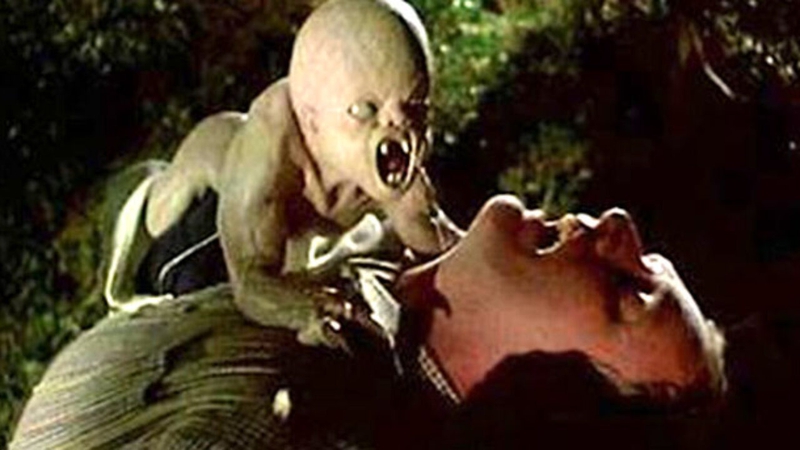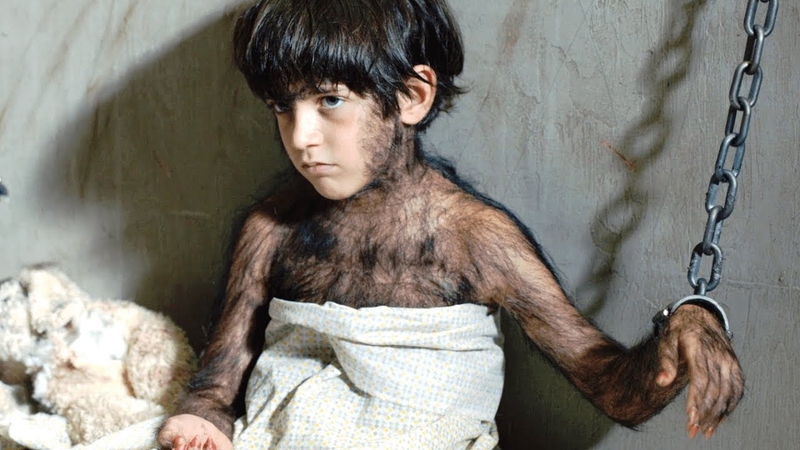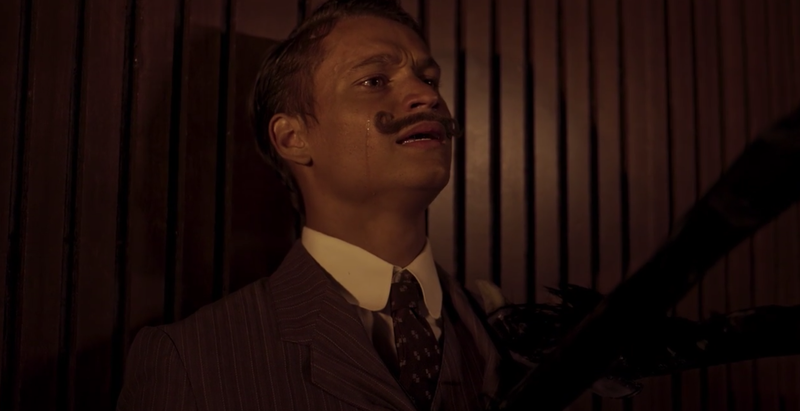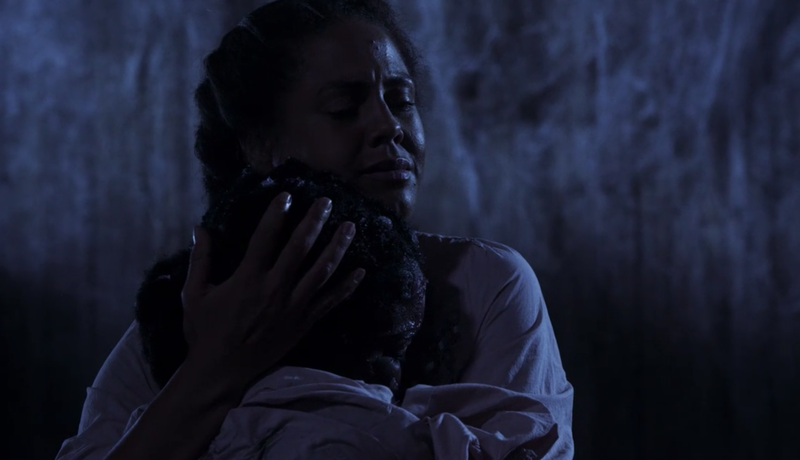When children appear in films like The Shining, Child’s Play, It, The Sixth Sense, Little Monsters, and Vampires Vs. the Bronx, they do so to tell stories about the corruption of innocence; stories where encounters with monstrosity are framed as coming-of-age events. While undoubtedly the dominant perspective in the contemporary, this rendering of childhood (both a stage of life and state of being) as a sanctified “blank slate” of moral purity primarily exists in theory rather than policy.
At the material level, children and adolescents have, for most of human history, been seen and treated socially as monstrous beings—not just “little adults” as is often described, but as savage creatures to be tamed into submission. Negative social perception and limited legal protection (if existent at all) resulted in centuries characterized by astronomical rates of infanticide and pedicide, particularly of Black, native, disabled, neurodivergent, queer, and/or intersex children. While it’s widely accepted that modern conceptions of childhood were “invented” in the eighteenth century, this assessment applies primarily to wealthy white children. Historian Stephanie Jones-Rogers offers ample evidence in her book, They Were Her Property: White Women As Slave Owners in the American South that slave ownership was a social, professional, and financial identity children were groomed into from infancy for the express purpose of inheriting and propagating the continuation of a white supremacist society. Violent moral panic about the sanctity and safety of white childhood that ignores the material violence inflicted on children of marginalized racial, ethnic, national, sexual, and/or gender identities has always been and continues to be a worldbuilding strategy toward the perpetuation of a perversely homogenous future.
Films like Rosemary’s Baby, The Exorcist, The Omen, The Brood, Children of the Corn, The Lost Boys, The People Under the Stairs, Interview With The Vampire, The Ring, The Witch, and The Girl With All the Gifts all feature children in monstrous, feral forms who challenge, refuse, and trouble “the natural order” of adult dominion. Some are literal monsters (Frankenstein, Interview With The Vampire), some are subject to undue influence (Rosemary’s Baby, The Exorcist), and some are human children who are simply born bad (The Omen, The Brood). Oftentimes, they present a “good” child to contrast the “bad” ones (The Shining, The Brood, The Ring, The Lost Boys). Still, no matter their orientation, these renderings of children as The Swallowing reveal distinctly adult anxieties about power retention and control. How does this anxiety appear in It’s Alive, Good Manners, and the segment of Shudder’s Horror Noire anthology entitled “Bride Before You”? How does control of the child’s body ultimately indicate adult attempts to control the future?

It’s Alive (1974)
Perhaps more than any other human event save for death, pregnancy is experienced along a spectrum that ranges from saccharine awe to pure terror, the tensions of which fuel Larry Cohen’s 1974 classic, It’s Alive. Among the more successful cinematic adaptations of Frankenstein, we’re introduced to husband and wife, Frank (John P. Ryan) and Lenore Davis (Sharon Farrell) in a moment of idyllic anticipation, shortly before the birth of their second child. That is until, as is often the case in real life, the birth takes a horrifying turn. During delivery, Lenore repeatedly tells her doctor “this pregnancy” and “this baby [were] different” from her first, pleas which go ignored. There’s a psychologically terrifying quality to these exchanges that are perhaps best exemplified in Rosemary’s Baby (the terror of being ignored, gaslit, certain something is wrong with no power to change anything), which quickly gives way to a more material horror: Lenore- still in stirrups, still bleeding- screaming while surrounded by the ravaged corpses of her birthing team. We learn the infant has killed them all and, somehow, escaped through the room’s sunlight.
If kaiju and their American counterparts, the giant insect sci-fi horror films of the ‘50s were a response to the anxiety of atomic age technology, It’s Alive similarly creates a monstrous entity to confront anxieties around pharmaceuticals, particularly oral contraceptives which were still relatively new at the time, having first been approved by the FDA in 1960. When the radio reports on the murders, names the family, and describes the infant as “born in a mutated form,” it triggers the cannibalistic hunger of various institutional entities- the media, police, medical researchers, and pharmaceutical companies- as they seek to consume both the baby and couple through either morally self-righteous hysteria or pure greed. Lenore’s revelation that she had been on birth control for almost three years prior to conception is in contrast with an executive’s fretting: “If we find out that the cause is medication that we manufacture and was administered over a long period of time, well, uh, it’d be bad for you and even worse for us. We’re susceptible, you know, to lawsuits.”

As the Davis’ lives unravel, the frightened infant prowls the surrounding community. Because these particular scenes are framed through his perspective, the film takes on the quality of a slasher, but- like Jaws- the baby is still a devouring entity, and he’s revealed to us most clearly in the moment of attack. At these particular points, the perspective changes to frame his fanged mouth as he lunges toward the camera. As far as representations of The Swallowing go, it’s both ridiculous and ridiculously effective.
Meanwhile, pressure to find and kill the infant mounts, and parallels are increasingly drawn between Frank and Mary Shelley’s Dr. Frankenstein. The book is repeatedly referenced, its core questions about who the monster of Shelley’s narrative is thoroughly considered, though stark differences do exist between the characters. For one, Dr. Frankenstein intentionally constructs his Creature and brings it to life through “unnatural” technology, where Frank and Lenore conceive the baby “naturally,” so to speak. Second, Frankenstein rejects his creation, but Frank is initially sympathetic, chastising a doctor who attempts to dehumanize the child: “Whatever it is, you can’t classify it as an animal. It’s human, doctor, and that’s what’s disgusting to you, isn’t it?” The question is poignant and comes to characterize his personal journey where sympathy transforms to murderous repugnance transforms back into sympathy.
In one of several attempts to distance himself from the infant, Frank asks why everyone is looking at him “like it’s my own flesh and blood or something,” though he undoubtedly is. It’s a disassociation both suggested and encouraged by the figureheads of those same institutions that seek to profit from his death. Both characters represent father figures who not only consider their children abominations, but actively seek to destroy them in the preservation of a future legacy that is orderly, clean, respectable, and free from the perceived blight of difference. While Frank does come around in the end, the baby is nevertheless executed by a lynch mob of cops. What questions are raised about the tyranny of patriarchal institutions and their influence on how fathers relate to and perform love of family?

Good Manners (2017)
Written and directed by Juliana Rojas and Marco Dutra, 2017’s Good Manners raises similar questions as It’s Alive, but ultimately takes the narrative to far different places. While the influence of Frankenstein can also be read here, to do so would be to ignore the film’s entirely unique usage of the werewolf mythos.
When Clara (Isabél Zuaa) accepts a nanny position for Ana (Marjorie Estiano), the estranged daughter of a wealthy family who is both very pregnant and seriously lacking in boundaries, the two develop an intimacy birthed from the power dynamics of race and class that exist between them. Clara tends to Ana’s every need, which is how she comes to realize Ana sleepwalks- amongst other nocturnal activities- on nights where the moon is full. The first of these episodes results in a kitchen scene (not dissimilar to the one in Jennifer’s Body) where Ana’s consumptive hunger overlays sexual desire. However, the romance between them is disrupted when the baby eats its way out of Ana’s belly Breaking Dawn-style. Though Clara’s first instinct is to shoot the baby werewolf, she can’t bring herself to pull the trigger, nor is she able to abandon him. Instead, she brings him to her home outside São Paulo and raises him as her son.

Reintroduced on his seventh birthday, we find Joel (Miguel Lobo) and Clara surrounded by supportive community who are nevertheless increasingly suspicious of Joel’s monthly bouts of illness, not to mention the restrictions on both his time and diet (vegetarian, like the cannibals in Raw and vampires in Twilight). Clara goes to extreme lengths to manage and conceal his condition but withholds the truth of his birth in an effort to protect him. Her love for Ana lives in her love for Joel, who she has raised essentially as their son. When Joel eats meat for the first time, the hunger it satiates also awakens his more animalistic instincts, most notably his rage toward Clara for the lies he eventually discovers, and- like most kids- for her rules; for not letting him “do anything.”
The werewolf has long been used both as a metaphor for puberty (Ginger Snaps, Teen Wolf) and monstrous renderings of the toxic masculine (The Howling, An American Werewolf in Paris). The adoptive Black lesbian mother of a white boy-child, Clara struggles in equal measure to protect Joel while protecting others from him. It’s a struggle that is both common to parenthood and incredibly specific for the racial dynamics. As a Black woman, how does one foster a healthy white masculinity when the world wants him to hate you?
Both Joel and Clara go to increasingly desperate lengths- her, to protect him, him, to become himself- until the secret can no longer be contained. The community that so beckoned turns on him, but Clara’s love is unwavering. In his most monstrous moment, she relinquishes control and, without fear, embraces his monstrosity. It’s precisely this acceptance that leads him to embrace her back, so that they may face what comes together. In one way, Joel is her greatest fear; in another, he’s the physical embodiment of her and Ana’s love, the manifestation of a future where that love lives on.

Bride Before You (2021)
Zandashé Brown is no stranger to southern gothic, and her directorial vision brings Stephanie Malia Morris’ short story, “Bride Before You,” to brilliant, beguiling, heartbreaking life as a segment of Shudder’s Horror Noire anthology feature. Set during Reconstruction, we’re introduced to Mrs. Clay (Lenora Chrichlow) as the new wife of Theodus Clay (Sean Patrick Thomas), a powerful member of Washington’s “colored aristocracy.” The couple is the typified picture of Black excellence: a dark-skinned, respectably wealthy man beside a light-skinned wife. All the tensions between them exist between intracommunal class/caste conflicts; the generational curses that represent slavery’s true legacy. When he scoffs at her having brought a spinning wheel along to Washington as though she were “a common slave,” she rebukes his degradation: “Well, it was spinning cotton that kept my people from being a common slave. The wheel got us out of the field, and the loom got us out of Virginia and up to Harlem. Better as a hobby than anything else, don’t you think?”
Though she performs the role of dutiful wife to his face, it’s clear that Mrs. Clay has her husband’s number. She’s acutely aware that “he chose me to provide the right kind of baby,” which is to say, a light-skinned or racially ambiguous child. When conception becomes a struggle, she seeks assistance from the local root woman (Gail Everett-Smith), who happens to be an auntie to her servant, Sabine (TiJuan Mosley), again pointing to intracommunal class dynamics. Not content to merely request a boy (“Better for the child,” the healer comments. “Girls get traded like horses, don’t they?”), she asks specifically that the baby “favor me, not his father,” and that she be free of the memory of this choice.
Despite warnings that if “you want to breed the Blackness out your child, it’ll cost you more than we been payin’ since they first held us down with chains to lay with us,” Mrs. Clay takes the remedy enthusiastically, and it works without fail. She becomes pregnant but, out of step with Southern society, also becomes the object of gossip that never relinquishes, even after she births a “perfect” son, Cornelius (Tyriq Withers), with the “bright skin,” “straight hair,” and “good breeding” his parents so desired. But with his birth came the haunting. Though years pass where jokes about ghosts and raccoons come readily, Mrs. Clay’s uneasiness never ceases.
Cornelius becomes engaged to Clara (Samantha Neyland), the equally light-skinned daughter of another wealthy “respectable” Black family who- “taught from her first breath that everything belonged to her”- is more deeply invested in her proximity to whiteness and treats both Mrs. Clay and Sabine with that particularly Southern form of sweetened disdain. When she mysteriously turns up dead, it’s explained as the result of a deadly spider bite. Still, the Clays’ social standing is irreparably tarnished, and both Theodus and Cornelius leave Mrs. Clay and the house for better prospects. Becoming a ghost herself, she remains with Sabine, the haint, and her spinning wheel while mentally unraveling into an incarnation of the Madwoman in the Attic.

Years later, Cornelius returns, married with a pregnant wife who wants to bring his mother back to Tulsa until she too meets a sudden end. He realizes, “This house has never been haunted. There’s something else here. A monster.” It’s not until he actively seeks her out that she reveals herself to him, identifying herself as “the firstborn and the twice punished—your sister. I’ve been here this whole time, waiting for our mama to claim me.” We come to discover that “the cost” to which the root woman referred, was Mrs. Clay’s first child, a beautiful girl whose darkness rendered her first monstrous then invisible to the eyes of her mother. Though we never see the monster’s complete form, she is spider-ish in nature, and the parallels between spinning cotton and spinning webs are thrown into stark relief.
“It’s not just men who hunger, who want…. Women want just as much,” Mrs. Clay narrates. “They teach us to hate ourselves. Our skin first, and then to hate each other.” Entangled in legacies of colorism and internalized anti-Blackness, her two children- the light son and dark daughter- represent two visions of Black futurity. One indulges the lies told by white supremacy; the other rejects them. While the short ends on a deeply moving note, the question still remains: who is the true monster of Mrs. Clay’s story?







